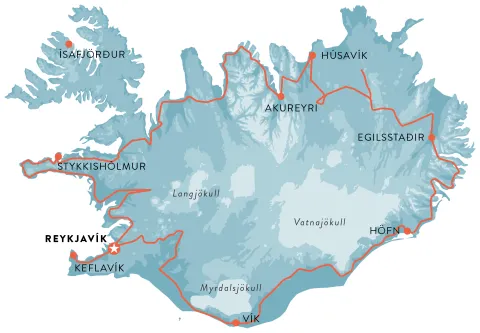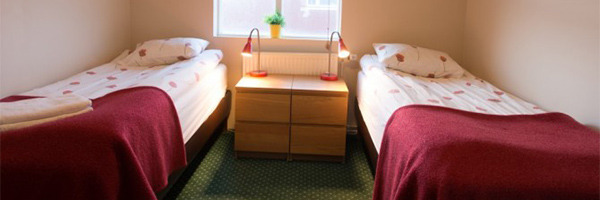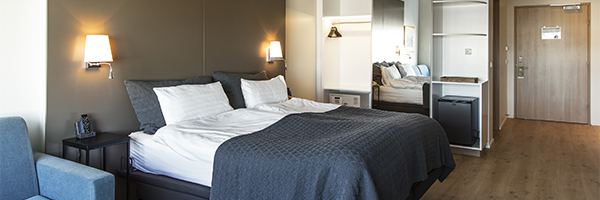Accommodation standards
You can choose between three different types of accommodation on this trip.
If you book two or more rooms then they will all need to be of the same type.
Apr - May fr. £1,560
Jun - Aug fr. £2,030
Sep - Oct fr. £1,965
This road trip takes you around the ring road, which circles all of Iceland (highway 1). Experience all the extreme, beautiful and fascinating wonders along the way. You will drive over highland plateaus, through barren lave landscapes and lush farmlands, along the coast and into fairytale fjords with mighty mountains towering over you and glaciers sparkling in the horizon. Let yourself be seduced by Iceland’s ever changing and contrasting scenery. This trip is one of our most popular during summer, and gives you ample time in Reykjavík and on the road.
Departures 2026: 1 January - 22 October; daily.
Driving Distance: 2330 km (50-320 km/day)
Included & add-ons

Reviews

"<% review.Body %>"
Recommended by
<% review.Signature %>
anonymous
Not recommended by
<% review.Signature %>
anonymous
Created <% review.Completed | toLocaleDate %>
Shows <% reviewsToDisplay.length %> of <% TotalNrReviews %> comments
Share your experiences and join Vulkan's photo contest My Magical Iceland, where you can win a gift card worth £750!
@vulkantravelgroup | #vulkantravelgroup | #mymagicaliceland
Day description

You will arrive at Keflavík Airport either in the morning or in the afternoon. Your rental car will be ready for you to pick up at the airport. On your way to Reykjavik, you have the option to visit the world-famous Blue Lagoon, one of Iceland's most iconic destinations. Please note that the visit is not included in the package and must be pre-booked as an optional add-on.
The Blue Lagoon is situated like an oasis in a lava field between the airport and Reykjavik. The mineral-rich waters maintain a pleasant temperature of 36–39°C year-round. The area also features an indoor lagoon, a geothermal sauna, and a restaurant offering both light meals and à la carte options.
After your relaxing visit to the Blue Lagoon, you will continue to Reykjavik for your first overnight stay. Depending on your arrival time, you’ll have the opportunity to explore the city on your own in the afternoon or evening.

Today is the day for visiting some of Iceland’s most famous and interesting attractions. First stop is UNESCO World Heritage site Thingvellir National Park, where both the history and the geology are fascinating. We recommend walking in the Almannagjá crack (created by the European and the North American continental plates sliding away form each other) and on to the area where the Icelandic Alltinget was formed around the year 930. This was the world’s first ever parliament.
Continue on to the famous geothermic area of Geysir, where Strokkur, Iceland’s most active geyser, spurts its majestic column of water into the sky every 5-7 minutes. You can wonder among bubbling mud pits and steaming underground springs and really feel the forces of nature beneath you feet!
Close to Thingvellir national park is the majestic Gullfoss waterfall, ”The Golden Waterfall”, by many regarded the most beautiful in Iceland. The waterfall has two stages and it is possible to get close to the mighty flow of water, which hurls down into the ravine below.
Another worthwhile place to visit nearby is the historic and probably most culturally important place in Iceland, Skáholt, which was the Episcopal seat of Southern Iceland for hundreds of years. Continue on from there for an overnight stay in the Selfoss area.

Travel south and along the Southern coast until you get to the waterfalls Seljalandfoss and Skógarfoss, two stops not to be missed. You can walk behind the curtain of water at Seljalandsfoss, and at Skógar you can also find an interesting museum on the history of Iceland.
Drive on towards the town of Vik, where you can visit he beautiful cliffs of Dyrhólaey, richly populated by migrating puffin birds from springtime to the middle of August. Dyrhólaey is well worth a visit outside the puffin season too. From Vik you drive over the Mýrdalssandur plain and pass the lave field Eldhraun. It is also possible to drive around Eldhraun to the South of it and pass through the isolated farmland area of Medelland before hitting the main road again on your way to the area of Kirkjubaejarklaustur, where you stay overnight.

Continue you journey over the magnificent river delta Skeidarársandur, where you can see the results of volcanic outbreaks beneath Europe’s largest glacier Vatnajökull, creating glacial rivers that have taken everything in their path with them. Reaching Skaftefell national park you can take in both the close by glacier and Iceland’s highest peak, Hvannadalshnúkur (2119 metres above sea level).
The glacial lagoon Jökulsárlón can be found at the foot of the glacier. Icebergs released from the glacier float in the lagoon, creating an almost magical atmosphere. The over 1000 year old clear blue ice protrudes the glacial tongues, and if you are lucky some curious seals will poke their heads up between the icebergs. An approximately 1 km long river leads straight from the lagoon into the Atlantic Ocean.
It is possible to take a short boat trip on the lagoon amongst the icebergs (additional fee). Continue onto to Höfn area for your overnight stay.

Continue along the coast, passing fishing villages like Djúpivogur. The coastal landscape changes and steep mountainsides and bottomless fjords take over, interspersed by rock formations worn by the sea to resemble statues reaching for the sky.
To get to Egilsstadir you either choose ”the fjord route”, which passes fishing villages like Berufjördur, Breiddalsvík, Stödvarfjördur, Fáskrúdsfjördur and Reydarfjördur – or the main road over the highlands pass of Breiddalsheidi. Overnight stay in the area of Egilsstadir, the main trading town in eastern Iceland.

Drive through the desert and moonlike landscapes of the highlands in the morning and if you wish to make a short detour a visit the old and welcoming cafe at one of the most isolated farms in Iceland, Möðrudalur, is recommended. From here you turn north towards the mighty Dettifoss, Iceland’s most powerful waterfall. The fall height is an impressive 44 metres and the masses of water exudes and impressive mist!
After visiting Dettifoss, you can either drive back to road no 1 and continue directly to Mývatn, or you can continue north and drive around the Tjörnes peninsula. If you choose to do the latter continue on to Ásbyrgi, an escarpment shaped as a horseshoe, believed to be the hoof print of Odin’s house Sleipner. From there you drive along the beautiful coastal roads on the Tjörnes peninsula until you reach the charming fishing village of Húsavík. Húsavík is the centre for whale watching in Iceland, and from there, several 3-hour whale-watching trips are offered every day. Overnight stay in the area surrounding Myvatn/Husavik area.

Spend the day in the nature reserve surrounding Mývatn Lake, one of Iceland’s most fascinating areas. Fantastical volcanic rock formations, geothermic activity and the lake itself with its varying surrounding flora and fauna await you. Use the tourist information office to get more detailed information about walking paths and other facts about the area.
Options here include visiting the twisted lava formations of Dimmuborgir, exploring the volcanic craters of Skútustaðir, or paying Námaskarð a visit to experience the sulphurous gases and steam coming from the ground of this volcanic area, and visiting the volcano itself, Krafla. A 2-hour walk brings you up to Leirhnjúkur, a volcanic crack, which had a volcanic outbreak as recently as 1984. There is also an outdoor natural lagoon reminiscent of the famous Blue Lagoon in the area, well worth a visit to relax after the active day.
In the evening drive on to Akureyri . On the way to Akureyri, you can make a stop to see the beautiful Godafoss waterfall. Following road nr. 1, you arrive in Akureyri, the capital of the north. Overnight in Akureyri area.

In Akureyri you can see the town’s modern church, the charming old part of town (Innbær), the amazing botanical garden and its shops, cafés as well as a large swimming pool.
Follow then the road nr.82 in direction to Dalvik and Olafsfjördur. North of Olafsfjördur you drive through a newly opened tunnel and reach the fishing village Siglufjördur. This beautiful old village is situated in a scenic fjord between high mountains. In the 1950s Siglufjördur was the centre og herring fishing in Iceland and you should visit the local herring museum which gives a good impression of the importance of these times for the Icelandic economy.
Two other places in Skagafjördur are of high historical interest; Hólar and Hofsós. Hólar is located in Hjaltadalur Valley, a beautiful mountain valley and is the former residence of the bishop of North Iceland. This was an important cultural centre in the middle ages and there you can see the old church which beholds precious art treasures that are rarely found elsewhere in Iceland. Hofsós is a small fishing village on the east side of Skagafjördur. It became known at the end of the 19th century as a harbour from which many Icelanders emigrated to the "new world" in search for a better life. The Emigration Center at the old harbour tells their story today.
In Skagafjördur you should also visit the turf house-museum in Glaumbær and the turf church Vidimýri (near Varmahlid). The turf buildings in Skagafjördur are two of the best preserved in the country. Drive on to overnight in Skagafjördur area.

In the morning you head to the south to the Snaefellsnes peninsula you can make a short detour to Haukadalur to visit the reconstruction of the home of Erik the Red, who settled later in Greenland with his son Leifur Eiriksson, the first white man sailing to America. This chapter in Viking history is told in the museum there.
Then you go to Stykkisholmur a charming town located in an ideal setting overlooking the Breidafjördur Bay. If you have the time you could make a stop at the Bjarnarhöfn Farm located by the sea not far from Stykkisholmur. It is one of the few farms in Iceland where there is shark exploitation and where visitors can stop by and learn about shark fishing around Iceland and taste the shark.
Traveling along the north coast of the peninsula you find typical Icelandic fishing villages like, Grundarfjördur, Olafsvik and Hellisandur. The Snæfellsnes peninsula is a nature wonder famous for the Snæfell Glacier that towers above the region. When driving around the peninsula we recommend a stop at Djúpalónssandur, an old fishing-station now abandoned, where you can also take a walk down to Dritvík the black sand beach nearby. Further on you reach Arnarstapi, a beautiful fishing village that has a unique natural port where you can see basalt columns of all sizes and shapes. In Arnarstapi it is possible to take refreshing walks to the sea.
Following the sout coast you continue to Búdir, a former port of commerce where today you can see a beautiful wooden church surrounded by a magnificent lava field.
Overnight on Snaefellsnes peninsula.

Follow road nr. 54 on the south coast of Snaefellsnes to Borgarnes.
You can stop at Gerduberg basalt columns, situated east of road nr. 54 near “Ytri-Raudamelur or take a hike to the picturesque Eldborg crater. Finaly you reach Borgarnes, where the Settlement Center museum is worth visiting.
Then you can drive in direction of Reykholt. This road leads you to Deildartunguhver, Iceland´s largest hot spring in terms of water production per second and to Reykholt where the famous 13th century author Snorri Sturluson used to live. In Reykholt you can still see the warm water basin that was used for bathing in medieval times and you can visit the permanent exhibition dedicated to the life and work of Snorri Sturluson in Snorrastofa. Some 20 km east of Reykholt you should visit the splendid waterfalls of Hraunfossar, where the water tumbles out of the lava into a passing river and the nearby Barnafoss Waterfall. On your way back to Reykjavik you have 2 options: you can either take the underwater tunnel under Hvalfjördur or drive along the Hvalfjördur Fjord (approx. 45 min. longer drive). Hvalfjördur (whale fjord) was an important naval station for the Americans during the World War II. It was also the location of a whaling station until 1986.
Overnight in Reykjavik.
Return flights either early in the morning or in the afternoon. Drive from Reykjavík to Keflavík airport (approx. 45 mins) and leave the car there in connection with your return flight.






You can choose between three different types of accommodation on this trip.
If you book two or more rooms then they will all need to be of the same type.

In this category, you can expect to stay in family-run guesthouses, country hotels, or even renovated farmhouses. Feel immersed in Icelandic charm while always enjoying your own private and comfortable bedroom. Bathroom facilities are shared with other guests, though some rooms have washbasins. Towels and bed linen are included in all accommodations. Each morning, enjoy a hearty breakfast on-site, always included in the cost.
Examples: Snorri Guesthouse, Efstidalur Farm Hotel, Glacier World Guesthouse.

Our Comfort category offers charming rooms in country hotels, guesthouses, or farmhouses, always with private bathroom facilities. They’re the perfect base to relax in after your day’s adventure in Iceland, and each morning before more sightseeing. You’ll also enjoy a daily breakfast buffet, included with each night’s stay.
Examples: Hótel Klettur, Hótel Dyrhóley, Hótel Hallormsstaður.
With our quality category, you’ll get the best available accommodation from our selection of hand-picked hotels. You can expect restful rooms with comfortable furnishings and private bathroom facilities. Before each day’s adventure, fuel up with a breakfast of local specialities, always included. A lot of accommodation at this level also offers superb restaurants and bars on-site. That way, you can indulge in some evening relaxation.
Examples: Examples: Fosshótel Reykjavík, Hotel Katla superior room, Hotel Kea Akureyri.